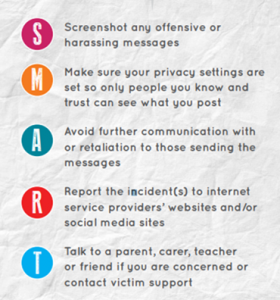Cyber-bullying
Cyberbullying is bullying that takes place online. Unlike bullying in the real world, online bullying can follow you wherever you go, via social networks, gaming and mobile phone.
Cyberbullying can include:
- Sending threatening or abusive text messages
- Creating and sharing embarrassing images or videos
- Trolling – the sending of menacing or upsetting messages on social networks, chat rooms or online games
- Excluding children from online games, activities or friendship groups
- Shaming someone online
- Setting up hate sites or groups about a particular child
- Encouraging young people to self-harm
- Voting for or against someone in an abusive poll
- Creating fake accounts, hijacking or stealing online identities to embarrass a Young person or cause trouble using their name
- Sending explicit messages, also known as sexting
- Pressuring children into sending sexual images or engaging in sexual conversations.
What to do if someone is bullying you or your friend online?


If you feel worried about something, talking about it can help make you feel better. The best thing to do is talk to an adult, a friend or someone who you know you can trust. But if you can’t tell anyone you know, you can always contact Childline on 0800 1111 to talk about cyber-bullying or anything else that has made you feel unsafe, scared or worried online.
You can also report anyone who is bullying you to the platform that’s carried the offending comments, audio, image or video. Follow these links to contact some of the most popular social media platforms and learn more about blocking and reporting:
Instagram> Snapchat> WhatsApp> Facebook> TikTok>
You can read more about cyber-bullying here.
